新东方——倒装句之完全倒装
- 格式:pdf
- 大小:135.80 KB
- 文档页数:2
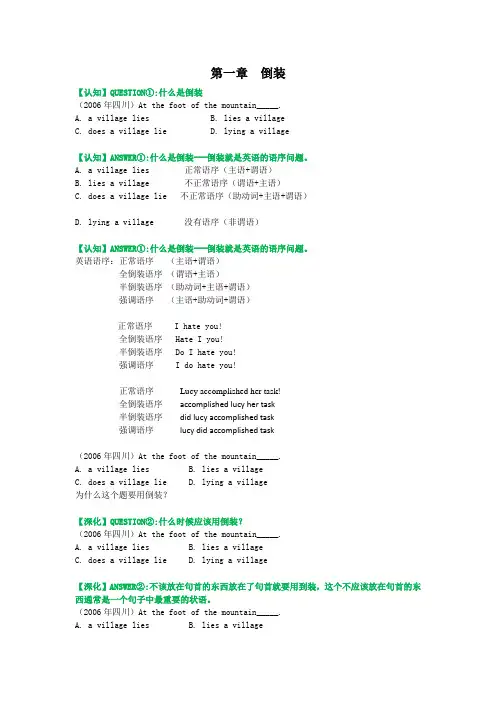
第一章倒装【认知】QUESTION①:什么是倒装(2006年四川)At the foot of the mountain_____.A. a village liesB. lies a villageC. does a village lieD. lying a village【认知】ANSWER①:什么是倒装---倒装就是英语的语序问题。
A. a village lies 正常语序(主语+谓语)B. lies a village 不正常语序(谓语+主语)C. does a village lie 不正常语序(助动词+主语+谓语)D. lying a village 没有语序(非谓语)【认知】ANSWER①:什么是倒装---倒装就是英语的语序问题。
英语语序:正常语序(主语+谓语)全倒装语序(谓语+主语)半倒装语序(助动词+主语+谓语)强调语序(主语+助动词+谓语)正常语序 I hate you!全倒装语序 Hate I you!半倒装语序 Do I hate you!强调语序 I do hate you!正常语序Lucy accomplished her task!全倒装语序accomplished lucy her task半倒装语序did lucy accomplished task强调语序lucy did accomplished task(2006年四川)At the foot of the mountain_____.A. a village liesB. lies a villageC. does a village lieD. lying a village为什么这个题要用倒装?【深化】QUESTION②:什么时候应该用倒装?(2006年四川)At the foot of the mountain_____.A. a village liesB. lies a villageC. does a village lieD. lying a village【深化】ANSWER②:不该放在句首的东西放在了句首就要用到装,这个不应该放在句首的东西通常是一个句子中最重要的状语。
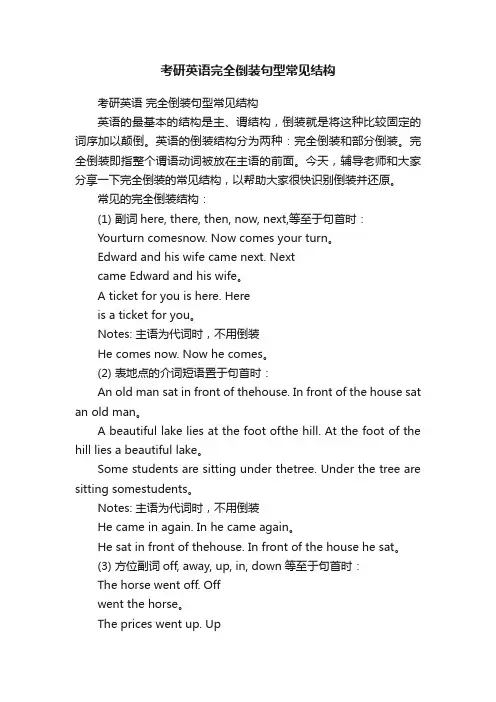
考研英语完全倒装句型常见结构考研英语完全倒装句型常见结构英语的最基本的结构是主、谓结构,倒装就是将这种比较固定的词序加以颠倒。
英语的倒装结构分为两种:完全倒装和部分倒装。
完全倒装即指整个谓语动词被放在主语的前面。
今天,辅导老师和大家分享一下完全倒装的常见结构,以帮助大家很快识别倒装并还原。
常见的完全倒装结构:(1) 副词here, there, then, now, next,等至于句首时:Yourturn comesnow. Now comes your turn。
Edward and his wife came next. Nextcame Edward and his wife。
A ticket for you is here. Hereis a ticket for you。
Notes: 主语为代词时,不用倒装He comes now. Now he comes。
(2) 表地点的介词短语置于句首时:An old man sat in front of thehouse. In front of the house sat an old man。
A beautiful lake lies at the foot ofthe hill. At the foot of the hill lies a beautiful lake。
Some students are sitting under thetree. Under the tree are sitting somestudents。
Notes: 主语为代词时,不用倒装He came in again. In he came again。
He sat in front of thehouse. In front of the house he sat。
(3) 方位副词off, away, up, in, down等至于句首时:The horse went off. Offwent the horse。
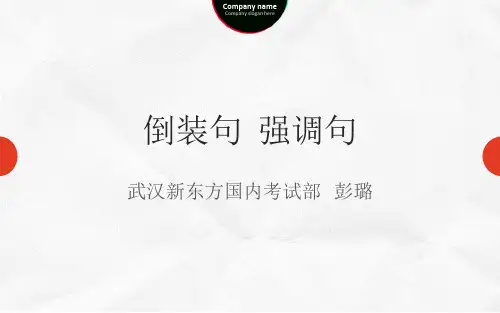
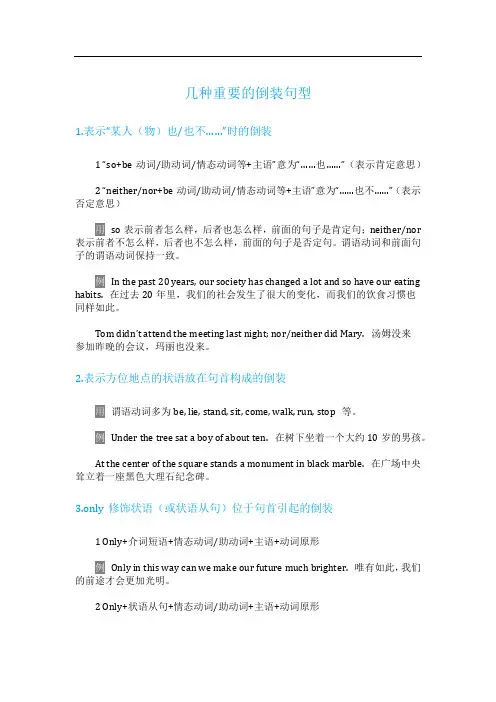
几种重要的倒装句型1.表示“某人(物)也/也不……”时的倒装1 “so+be动词/助动词/情态动词等+主语”意为“……也……”(表示肯定意思)2 “neither/nor+be动词/助动词/情态动词等+主语”意为“……也不……”(表示否定意思)so表示前者怎么样,后者也怎么样,前面的句子是肯定句;neither/nor 表示前者不怎么样,后者也不怎么样,前面的句子是否定句。
谓语动词和前面句子的谓语动词保持一致。
In the past 20 years, our society has changed a lot and so have our eating habits. 在过去20年里,我们的社会发生了很大的变化,而我们的饮食习惯也同样如此。
Tom didn’t attend the meeting last night; nor/neither did Mary. 汤姆没来参加昨晚的会议,玛丽也没来。
2.表示方位地点的状语放在句首构成的倒装谓语动词多为be, lie, stand, sit, come, walk, run, stop 等。
Under the tree sat a boy of about ten. 在树下坐着一个大约10岁的男孩。
At the center of the square stands a monument in black marble. 在广场中央耸立着一座黑色大理石纪念碑。
3.only修饰状语(或状语从句)位于句首引起的倒装1 Only+介词短语+情态动词/助动词+主语+动词原形Only in this way can we make our future much brighter. 唯有如此,我们的前途才会更加光明。
2 Only+状语从句+情态动词/助动词+主语+动词原形Only when you have a try, can you know whether you are fit for the jobor not. 只有当你尝试过,你才能知道自己是否适合这份工作。
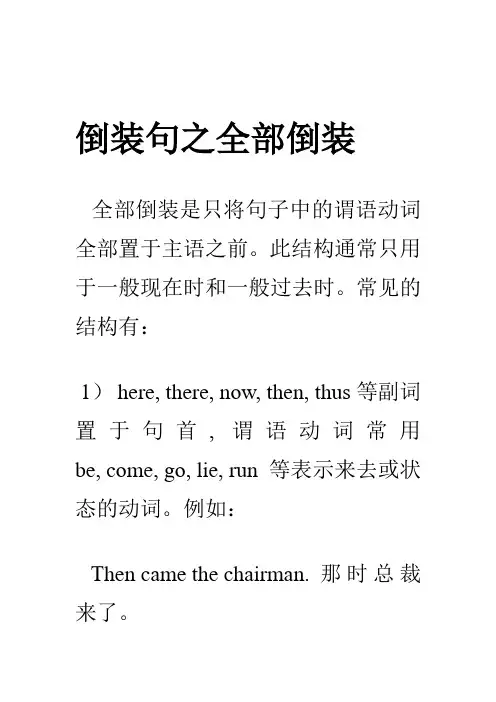
倒装句之全部倒装全部倒装是只将句子中的谓语动词全部置于主语之前。
此结构通常只用于一般现在时和一般过去时。
常见的结构有:1) here, there, now, then, thus等副词置于句首, 谓语动词常用be, come, go, lie, run等表示来去或状态的动词。
例如:Then came the chairman. 那时总裁来了。
Here is your letter. 你的信。
2)表示运动方向的副词或地点状语置于句首,谓语表示运动的动词。
例如:Out rushed a missile from under the bomber. 轰炸机肚底下窜出一枚导弹。
Ahead sat an old woman. 前面坐着一个老妪。
注意:上述全部倒装的句型结构的主语必须是名词,如果主语是人称代词则不能完全倒装。
例如:Here he comes. 他来了。
Away they went. 他们走开了。
倒装句之部分倒装部分倒装是指将谓语的一部分如助动词或情态倒装至主语之前。
如果句子的谓语没有助动词或情态动词,则需添加助动词do, does或did,并将其置于主语之前。
1)句首为否定或半否定的词语,如no, not, never, seldom, little, hardly, at no time, in no way, not until…等。
例如:Never have I seen such a performance.从未见过如此糟糕的表演。
Nowhere will you find the answer to t his question. 无论如何你不会找到这个问题的答案的。
Not until the child fell asleep did the mother leave the room. 母亲一直到孩子入睡后离开房间。
当Not until引出主从复合句,主句倒装,从句不倒装。
注意:如否定词不在句首不倒装。
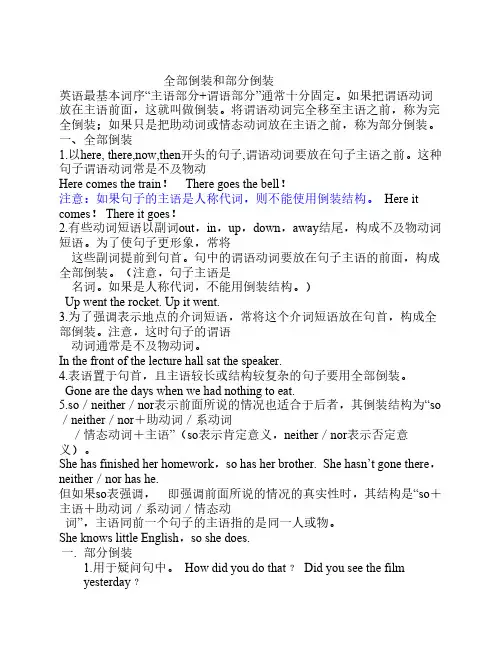
全部倒装和部分倒装英语最基本词序“主语部分+谓语部分”通常十分固定。
如果把谓语动词放在主语前面,这就叫做倒装。
将谓语动词完全移至主语之前,称为完全倒装;如果只是把助动词或情态动词放在主语之前,称为部分倒装。
一、全部倒装1.以here, there,now,then开头的句子,谓语动词要放在句子主语之前。
这种句子谓语动词常是不及物动Here comes the train! There goes the bell!注意:如果句子的主语是人称代词,则不能使用倒装结构。
Here it comes! There it goes!2.有些动词短语以副词out,in,up,down,away结尾,构成不及物动词短语。
为了使句子更形象,常将这些副词提前到句首。
句中的谓语动词要放在句子主语的前面,构成全部倒装。
(注意,句子主语是名词。
如果是人称代词,不能用倒装结构。
)Up went the rocket. Up it went.3.为了强调表示地点的介词短语,常将这个介词短语放在句首,构成全部倒装。
注意,这时句子的谓语动词通常是不及物动词。
In the front of the lecture hall sat the speaker.4.表语置于句首,且主语较长或结构较复杂的句子要用全部倒装。
Gone are the days when we had nothing to eat.5.so/neither/nor表示前面所说的情况也适合于后者,其倒装结构为“so /neither/nor+助动词/系动词/情态动词+主语”(so表示肯定意义,neither/nor表示否定意义)。
She has finished her homework,so has her brother. She hasn’t gone there,neither/nor has he.但如果so表强调,即强调前面所说的情况的真实性时,其结构是“so+主语+助动词/系动词/情态动词”,主语同前一个句子的主语指的是同一人或物。

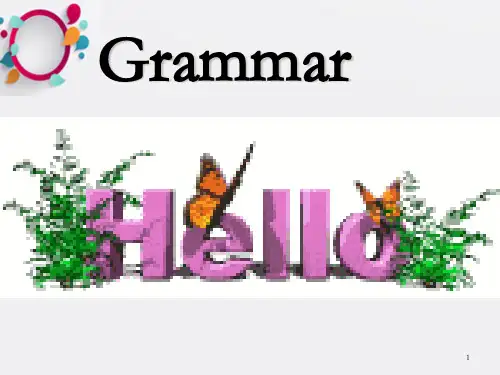

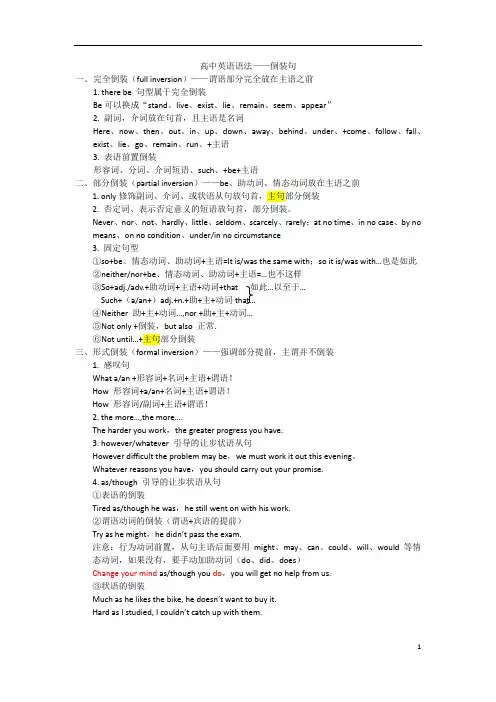
高中英语语法——倒装句一、完全倒装(full inversion)——谓语部分完全放在主语之前1. there be 句型属于完全倒装Be可以换成“stand、live、exist、lie、remain、seem、appear”2. 副词,介词放在句首,且主语是名词Here、now、then、out、in、up、down、away、behind、under、+come、follow、fall、exist、lie、go、remain、run、+主语3. 表语前置倒装形容词、分词、介词短语、such、+be+主语二、部分倒装(partial inversion)——be、助动词、情态动词放在主语之前1. only修饰副词、介词、或状语从句放句首,主句部分倒装2. 否定词、表示否定意义的短语放句首,部分倒装。
Never、nor、not、hardly、little、seldom、scarcely、rarely;at no time、in no case、by no means、on no condition、under/in no circumstance3. 固定句型①so+be、情态动词、助动词+主语=It is/was the same with;so it is/was with…也是如此②neither/nor+be、情态动词、助动词+主语=…也不这样③So+adj./adv.+助动词+主语+动词+that 如此…以至于…Such+(a/an+)adj.+n.+助+主+动词that…④Neither 助+主+动词…,nor +助+主+动词…⑤Not only +倒装,but also 正常.⑥Not until…+主句部分倒装三、形式倒装(formal inversion)——强调部分提前,主谓并不倒装1. 感叹句What a/an +形容词+名词+主语+谓语!How 形容词+a/an+名词+主语+谓语!How 形容词/副词+主语+谓语!2. the more…,the more….The harder you work,the greater progress you have.3. however/whatever 引导的让步状语从句However difficult the problem may be,we must work it out this evening。
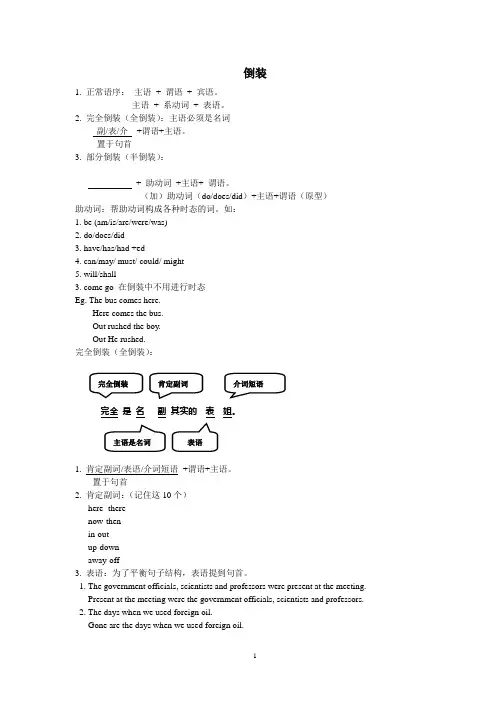
倒装1. 正常语序: 主语 + 谓语 + 宾语。
主语 + 系动词 + 表语。
2. 完全倒装(全倒装):主语必须是名词副/表/介 +谓语+主语。
置于句首3. 部分倒装(半倒装):+ 助动词 +主语+ 谓语。
(加)助动词(do/does/did )+主语+谓语(原型)助动词:帮助动词构成各种时态的词。
如:1. be (am/is/are/were/was)2. do/does/did3. have/has/had +ed4. can/may/ must/ could/ might5. will/shall3. come go 在倒装中不用进行时态Eg. The bus comes here.Here comes the bus.Out rushed the boy.Out He rushed.完全倒装(全倒装):完全 是 名 副姐。
1. 肯定副词/表语/介词短语 +谓语+主语。
置于句首2. 肯定副词:(记住这10个)here- therenow-thenin-outup-downaway-off3. 表语:为了平衡句子结构,表语提到句首。
1. The government officials, scientists and professors were present at the meeting.Present at the meeting were the government officials, scientists and professors.2. The days when we used foreign oil.Gone are the days when we used foreign oil.3. 介词短语:A little boy sat in front of the house.In front of the house sat a little boy.部分倒装If not so only as +助动词 +主语 +谓语。
【导语】有⼀个现象是普遍存在的,就是“学的越多感觉不会的越多,背的越多忘的越快”,这个问题困扰着很多考研党。
很多时候死记硬背并不是的⽅法,需要找到正确的思路,灵活记忆。
?⽆忧考为同学们提供⼀些知识点考研英语语法之倒装结构:完全倒装和部分倒装,希望能对⼤家有所帮助。
在英语表达中,由于语法结构平衡的要求,或是由于修辞的需要,往往要改变句⼦的⾃然语序,把⼀些本应置于主语之后的谓语、表语或状语等句⼦成分提到主语之前。
我们把这种语序的变化称为“倒装语序”。
这样的倒装语序可能使句⼦的内在含义产⽣细微的、甚⾄明显的改变。
只有了解引起倒装的原因,才能更准确地理解句⼦的含义。
下⾯万学海⽂就跟⼤家聊聊倒装语序。
倒装语序分为完全倒装和部分倒装。
完全倒装(FullInversion),⼜称“全部倒装”,是指将句⼦中的谓语全部置于主语之前。
部分倒装(PartialInversion)(⼜称半倒装句),指将谓语的⼀部分如助动词或情态动词倒装⾄主语之前,⽽谓语动词⽆变化。
如果句中的谓语没有助动词或情态动词,则需添加助动词do,does或did,并将其置于主语之前。
考研英语翻译中倒装结构的突破⼝在于:识别出倒装结构,并判断出主语和谓语,找到句⼦主⼲,理清句中各部分的关系。
翻译时既可以按照主谓语的顺序翻译,也可以按照英语表达顺序翻译。
下⾯列举⼏个真题范例。
⼀、状语位于句⾸,主语⾮代词,句⼦完全倒装【真题例句】With economic growth has come centralization; fully 76 percent of Japan’s 119 million citizens live in cities where community and the extended family have been abandoned in favor of isolated, two-generation households.【解析】第⼀个句⼦主语centralization后⾯紧跟着第⼆个句⼦介绍centralization的内容,为使其保持紧凑,所以将介词短语With economic growth置于句⾸,第⼀个句⼦采⽤完全倒装结构。
[转载]“完全倒装句”的形式及使用方法英语中的倒装句型是一种语法手段,用于表示一定的句子结构或强调某一句子成分。
倒装句有两种:完全倒装和部分倒装。
所谓完全倒装:就是将谓语动词置于主语前。
剑桥国际教育(中国)名师总结了完全倒装句的形式以及使用方法。
1、完全倒装一般具有以下两个条件:①谓语动词是单个(即不带情态动词、助动词或be)的不及物动词,且只限于一般现在时或一般过去时;②主语只能是名词。
here, there, out, in, up, down, now, then, away等副词放在句首,句子需要完全倒装[例句]Here comes the bus. =The bus is coming. 汽车来了。
There goes the bell! = The bell is ringing. 铃响了!Now comes your turn to make a short speech. 该轮到你发言了。
Then came the hour we had been looking forward to. 我们期盼的时候到了。
[注意](1)在这种情况下倒装仅限于不及物动词或be动词,像go, come, rush, live, stand, lie等。
(2)主语是人称代词时不要倒装。
如:Away he went. 他走远了。
表示方位的状语放在句首,句子完全倒装;谓语动词多为be, lie, stand, sit, come, walk, run, stop etc. 不及物词。
[例句]In front of the house stopped a police car. 房子的前面停着一辆警车。
Around the corner walks a young policeman. 拐角处有个年轻的警察在行走。
Under the tree sat a boy of about ten. 在树下坐着一个大约10岁的男孩。